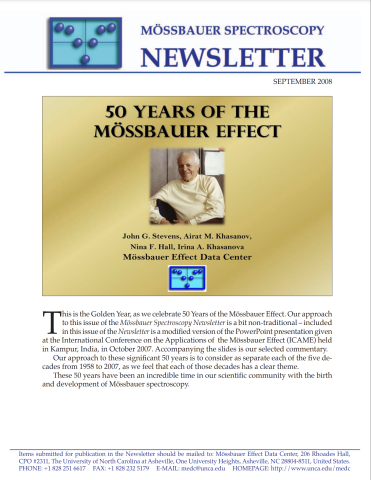50 Year of the Mössbauer Effect

This is the Golden Year, as we celebrate 50 Years of the Mössbauer Effect. Our approach to this issue of the Mössbauer Spectroscopy Newsletter is a bit non-traditional – included in this issue of the Newsletter is a modified version of the PowerPoint presentation given at the International Conference on the Applications of the Mössbauer Effect (ICAME) held in Kampur, India, in October 2007. Accompanying the slides is our selected commentary. Our approach to these significant 50 years is to consider as separate each of the five decades from 1958 to 2007, as we feel that each of those decades has a clear theme. These 50 years have been an incredible time in our scientific community with the birth and development of Mössbauer spectroscopy.
In the mid-1960s, a new phase began at Argonne when Michael Kalvius was recruited to the Solid State Science Division. By this time, Stan Hanna had left the Physics Division at Argonne and had been replaced by Stan Ruby. Ruby and Kalvius began working together and, during the next few years, their collaboration expanded to include two young solid-state physicists, Bobby Dunlap and Gopal Shenoy. Shenoy would remember later that they measured about 10,000 compounds during the Great Mössbauer Expansion period.
,In the mid-60’s Stan Ruby approached Irwin Gruverman of NENC, the New England Nuclear Corporation, suggesting that NENC sponsor a one-day Mössbauer Effect Methodology conference (MEM) in association with the winter meeting of the APS. NENC had become a principal supplier of radionuclides and ME sources and absorbers here and abroad. The series began on January 26, 1965, in New York City with free registration for all 250 participants. The 15 papers were presented in an afternoon/evening format. As needed, NENC paid the expenses of the chosen speakers, who generally were from labs in the USA. A pre-Symposium dinner the night before the presentations became an effective vehicle for the speakers and the organizers to meet each other. Manuscripts were published in Mössbauer Effect Methodology Volume 1 (through Volume 10) by Plenum Press, New York, edited by I. Gruverman.
,With the prodding and support of Stan Ruby, the Mössbauer Effect Data Center was established at the University of North Carolina at Asheville with a modest grant of $2,800 from the North Carolina Board of Science and Technology. The resources of Argonne National Laboratory were made available during these early years at the Center. Other funding during this time came from the National Bureau of Standards’s National Standard Reference Data Systems and the National Science Foundation, In 1969, MEDC developed one of the first databases used in the scientific community using IBM Assembler code.